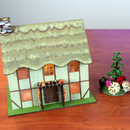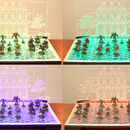Introduction: How to Design and Laser Cut a Gwent Board Inspired by Witcher 3
Gwent is a really cool card game first introduced in the video game Witcher 3. It's gone on to become a standalone video game, and it's a real card game as well! You can purchase cards in either the tarot card size or standard card size.
In this Instructable I show how to design a Gwent board in Adobe Illustrator, and laser cut it out of birch plywood. I show how to assemble and finish the board, and also how to make matching game tokens.
Step 1: Tools and Materials
Tools:
Access to a laser cutter (I use a 60 watt Universal cutter at my maker-space TechShop)
Design software (I use Adobe Illustrator)
A drill and drill brush (get one suitable for buffing wax)
Sandpaper (320 grit extra fine)
Sponge applicators (for cleaning up excess glue)
Staining pads, gloves and other finishing tools
4" x 4" granite samples for weights during gluing
Materials:
1/8" and 1/4" birch plywood
3/16" fluorescent acrylic (for tokens)
Danish oil or other wood stain
Briwax or other finishing wax
Fast Orange Smooth or other cleaner
Powerful rare earth magnets
Step 2: Basic Design and Design Constraints
A Gwent board has two sides for two players who traditionally sit across from one another. Each player has three tiers of played cards: close combat or melee cards, range cards and siege cards. There is a slot for weather cards that affect all played cards and each player has a king card that provides special powers. Each player also has their deck and discard piles.
There are two gem tokens for each player, and when a player loses a hand, a gem is removed from the board. When a player loses both gems, he/she loses that round.
My cards are tarot sized cards, so each card slot must be large enough to hold the cards, but my overall size constraint is the bed of my laser cutter, which is 24" x 18". Each half of my Gwent board will fit just inside these dimensions.
I grabbed a screenshot of the digital game and compressed it to my dimensions, to guide my layout. By using the reference size of a tarot card, I determined that with a little bit of adjusting I could comfortably fit everything I needed into my 24" x 18" space.
I will use a basic sandwich construction for my board, with each half having 3 layers: a 1/8" top with cutouts for the cards and tokens, a 1/4" middle that will hold the engraving that will show through the cutouts, and a 1/8" bottom. The "bottom" of the top half of the board is actually the top of the game when closed, and it will be engraved as well.
Instead of using hinges, which is a more traditional approach, I elected to embed powerful magnets in the corners of each board, to hold them together when not in use. I like this approach because it allows you to separate the boards and adjust to various table sizes. You can move them apart for large tables and put them side by side on a narrow table.
Step 3: Design the Board in Adobe Illustrator
I always start my designs by creating references, which I draw in green, a color that is ignored by my laser cutter. My key reference in this design is a tarot card outline, which I can place anywhere in the design to confirm a card will fit in a slot or to test to see how many cards will fit in a row. I used the card reference to create a single card hole with a finger slot at the top to make cards easier to remove.
My next step was to create the images I would need. This project has two types of graphics: black rastered images that are used to denote what type of card goes in each spot, and blue vector graphics that are purely aesthetic (I used a Celtic border in several places). These images were all based on clip art, and you can reference another one of my Instructables: How to Use Adobe Illustrator to Create Rose Motifs to learn more about using clip art to create Illustrator designs.
Then I laid out my top cutout layer, using red lines that my laser cutter interprets as cutting lines. Then in another layer of the drawing, I laid out engraving that would fit within the cutout lines.
For the other half of the board, I needed to reflect, or flip the design horizontally, both the cutting layer and the engraving layer. This allows the 'weather' trays to meet up at the top into a single, shared card tray, and aligns other elements of the board for visual coherence.
Finally, I created a design for the game 'lid', picking a nice font for the word 'Gwent' and using the same Celtic border I used inside.
Step 4: Design the Game Tokens
In the same drawing I created a layer for the gem game tokens. I also created a cutout hole to hold the token, with a finger slot at the top.
I've created a video tutorial that shows my complete process for designing and making tokens, so I won't go into detail on that here.
Step 5: Cut the Pieces on the Laser Cutter
The first thing I did was to test my critical settings. In this case, I wanted to see which raster settings would give me the best results in the least amount of time. I engraved various options using a single motif for my test, and opted to go with 40% power and 60% speed.
Then I cut one of my cutout layers, and tested to make sure a sample card I had brought with me fit properly in the hole.
Then I cut and engraved the middle layer that fit below this cutout and tested its fit. Each engraved layer takes 42 minutes to execute, so it is very important to do everything possible to minimize the chance of mistakes.
Once all the boards were cut, I cut the gem tokens out of my 3/16" red fluorescent acrylic.
Step 6: Prepare the Wood
Deep raster pockets will usually have some smoke and resin deposited where the burning smoke is pulled over the board by the ventilation. I use Fast Orange and a damp sponge to remove this smoke wherever I find it, and to clean the cut edges.
I use as little water as possible, but this process will still raise the nap slightly on the wood. I sanded all the boards with extra fine grit sandpaper, but I did not sand the edges because I wanted to retain the nice caramel finish.
Step 7: Stain, Wax, Glue and Buff
I wanted to stain the cutout layers a darker color and leave the engraved layers light, to better show the engraving. I decided to stain the gem holes because a rear engraved token shows up better on a darker surface. To do this, I put the layers together and outlined the gem holes with a pencil.
I used cherry colored Danish oil to stain the top and the gem holes on the middle layer. I let it set for about 30 minutes, then wiped off the excess.
I then applied Briwax with a soft brush that works the wax into the engraved areas. I covered all visible surfaces, including the stained surfaces, then wiped back the excess. I let the wax dry overnight.
Then I glued the boards together, using 4" x 4" granite samples as weights, and cleaned up any excess glue with damp sponge applicators that can get into small spaces.
Finally, I used a drill brush, one specifically for wax buffing, to buff the assembled surfaces. This brush can get into all the nooks and crannies of the board without damaging the surfaces.
Step 8: On Using Magnets
I made my decision to use magnets instead of hinges after leaving my maker-space. This meant I needed to make the holes with hand tools. It also meant I had to work within the available space in my current design.
The magnet holes are cut in the four corners of the middle layers, and are completely covered by the 1/8" boards front and back. The largest magnets the current design would accommodate are those shown in the photograph: .375 inches in diameter. These magnets work, but I would like the hold to be stronger. If I were to do this project again, I would adjust the design to allow for larger magnets.
Step 9: Enjoy Your Custom Gwent Board!
The finished board is pleasant to the touch and glows nicely from the buffed Briwax. The gem tokens look good in their gem holes, and the cards fit well in their cutout trays.
Although this board was designed for the tarot sized cards, It would be easy to adjust this design to handle the standard size cards. This adjustment would make it even easier to accommodate larger magnets!











